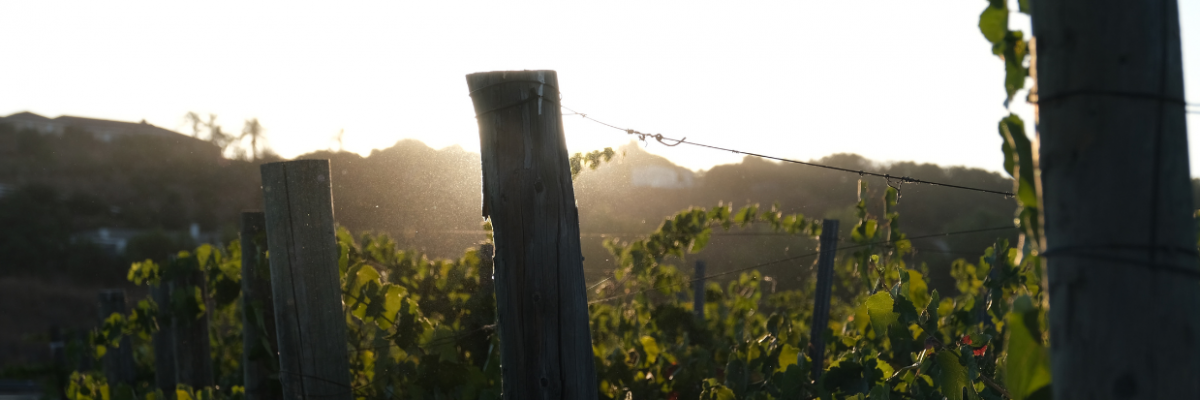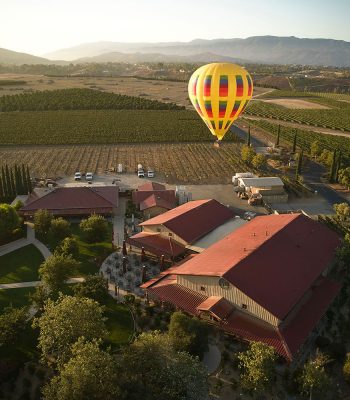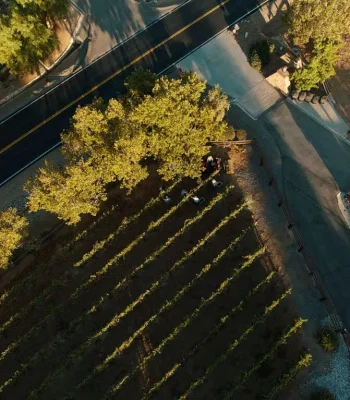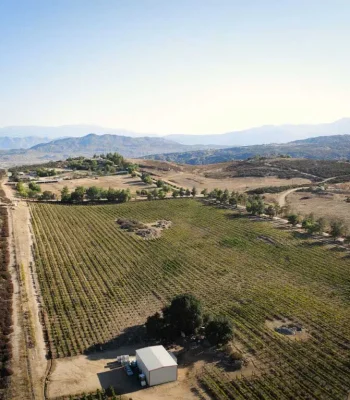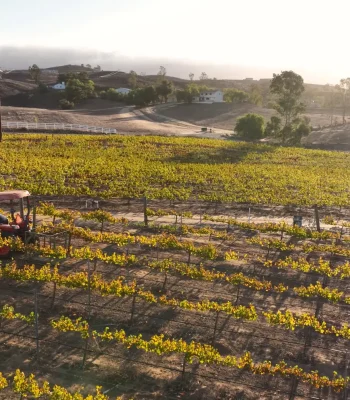How Our Vineyards Wake Up and Why Each One Matters
Every spring, something quietly magical happens in the vineyard. The vines, which have looked lifeless and bare all winter, start to wake up. Tiny buds begin to swell on the canes, eventually bursting open into the first bright green signs of a new vintage. It’s called bud break, and it’s one of the most exciting times of year in wine country.
Here at Wiens Cellars, it’s not just about watching the vineyard come back to life—it’s about reconnecting with the land we’ve spent decades tending and understanding. It’s about the promise of another season and the opportunity to make something extraordinary from scratch, yet again.
But before we dig into bud break and what it means for this year’s vintage, let’s take a step back and talk about our vineyards—where they are, why they’re so different from one another, and how that plays into the wines you love.
From the Ground Up
When we planted our very first vines by hand in 1996, we weren’t just starting a winery—we were making a commitment to the land. Fast forward to today, and we’re now farming nearly 100 acres, all still managed in-house, all still driven by the same philosophy: great wine starts in the vineyard.
That might sound like a cliché, but we mean it literally. Every vintage, every varietal, and every bottle starts as a tiny bud on a vine that we’ve pruned, watered, and watched over with care. And because we manage all of our vineyards ourselves—from the first cut of winter pruning to the final harvest—we’re able to shape our wines from the soil up.
Bud Break: The Season of Possibility
Before the first leaf appears, there’s a lot going on under the surface. As the soil warms up, the vines “wake up” from dormancy. Sap starts to flow. Buds begin to swell and eventually crack open—revealing the new shoots that will become this season’s canopy, flower clusters, and ultimately, fruit.
Bud break doesn’t happen all at once across all our vineyards. Because of differences in elevation, soil, and exposure, each site has its own internal clock. That’s part of what makes our wines so dynamic—each vineyard is on its own timeline, creating layers of complexity in the final blends.
So what makes our vineyards special? Let’s take a closer look.
The Heart of It All: Winery Estate Vineyard
If you’ve ever visited Wiens Cellars, chances are you’ve stood just steps away from our Winery Estate Vineyard, located smack dab in the center of Temecula Valley Wine Country. At 1,350 feet above sea level, this vineyard gets plenty of warm, sunny days balanced out by cool, breezy nights—thanks to the Rainbow Gap that funnels ocean air into the valley.
This kind of temperature swing, known as a diurnal shift, is ideal for growing balanced, high-quality grapes. Warm days help the fruit ripen, while the cool nights help the vines retain acidity, which is key for freshness and ageability.
The Winery Estate is home to some standout varietals, including Chardonnay, Montepulciano, and Syrah. Because it sits right next to the winery, this vineyard is also a great place for experimentation. It’s easy for our team to monitor changes, test new pruning methods, and observe how the fruit reacts in real time. Think of it as our “home lab” for viticulture.
Elevation, Elegance, and Expression: La Cresta Vineyards
Drive up into the hills that wrap around Temecula Valley and you’ll find yourself in La Cresta, where our highest-elevation vineyards reside. These vines sit well above the valley floor, soaking in misty mornings and basking in late afternoon sunshine. That slower, cooler ripening season creates wines with beautiful structure, finesse, and nuanced varietal character.
La Cresta is where we grow a dozen different grape varieties and where the majority of our fruit is harvested each year. It’s also the birthplace of some of our most prized wines—the Vineyard Designate Collection—a series of single-vineyard bottlings that showcase just how expressive and site-specific wine can be.
There’s something special about this place. The soils vary from one hillside to the next. The fog clings a little longer in the mornings. The sunlight feels just a touch softer. All of those subtle differences shape the way the fruit develops and, ultimately, how the wine tastes in your glass.
The Quiet Performer: Sage Vineyard
Tucked about 1,000 feet higher than our Estate Vineyard, the Sage Vineyard is a bit of a hidden gem. It spans 15 acres and grows nine different varieties, all in soil that’s a blend of fine sandy loam and decomposed granite.
Sage sees similar daytime temperatures to our valley-floor vineyards, but its slightly more inland location means it gets less direct maritime influence. The result? Smaller, more concentrated berries—perfect for crafting wines with richness, depth, and serious character.
This is the kind of vineyard that doesn’t shout for attention but always delivers. Year after year, it produces some of our most consistent fruit, with intense flavor and structure.
Bold from the Beginning: San Ignacio Vineyard
About nine miles northeast of the winery sits San Ignacio Vineyard, perched on a rugged hilltop that’s practically built for Bordeaux grapes. The vineyard is planted to Cabernet Sauvignon, Carmenere, Malbec, and Merlot, and each variety thrives in the sandy loam and decomposed granite soils.
Water is scarce here—on purpose. We use minimal irrigation, which forces the vines to dig deep and work harder. That kind of stress may not sound ideal, but in the world of wine, it’s often exactly what you want. Less water means smaller, more intense berries, packed with flavor and tannin—ideal for making bold, age-worthy reds.
The breezes that sweep through this vineyard keep disease pressure low and allow us to farm more sustainably. This is a site that produces powerful, structured wines that truly reflect their rugged surroundings.
Why Vineyard Diversity Matters
You might be wondering: why go through all the effort of managing vineyards in different microclimates and soil types? Wouldn’t it be easier to plant everything in one place?
Well, sure. But that’s not how great wine is made.
Each of our vineyards brings something unique to the table. From the high-elevation elegance of La Cresta to the bold intensity of San Ignacio, we’re working with a broad palette of flavors and structures. That allows us to create wines that are layered, complex, and true to their origins—whether it’s a single-vineyard bottling or a blend that brings several sites together.
Plus, having this kind of diversity builds resilience. If one site faces a weather challenge or a tricky season, another vineyard might balance things out. It gives us flexibility in the cellar and ensures that every vintage has something special to offer.
Bud Break, Then What?
After bud break, the vineyard quickly shifts into high gear. The new shoots grow rapidly, and soon we’ll start shoot thinning and training the canopy for airflow and light exposure. Flowering and fruit set follow shortly after, setting the stage for the rest of the growing season.
But right now, it’s all about potential. Each bud is a blank slate, and we get one shot per year to do it right. There’s something humbling about that—no shortcuts, no do-overs.
And because we know each vineyard so intimately, we can give it exactly what it needs to succeed. Whether it’s adjusting canopy management techniques in Sage, tweaking irrigation at San Ignacio, or evaluating fruit loads in La Cresta, our vineyard team is already hands-on, responding to the nuances of this new season.
Come See It for Yourself
Reading about vineyards is one thing. Walking among the vines, feeling the breeze, seeing those tiny green shoots for yourself—that’s something else entirely.
If you haven’t visited us in a while, spring is the perfect time. The vineyards are alive with energy. The air smells fresh and full of promise. And if you time it right, you might just catch the early signs of flowering—the next big step on the journey from vine to wine.
We believe wine is more than just what’s in the glass. It’s about the place it comes from and the people who bring it to life. That’s why we’re so proud to share our vineyards with you—and to keep pushing ourselves to do better, season after season.
Bud break is a beautiful reminder of nature’s rhythms and the hard work that goes into every bottle of wine. For us at Wiens Cellars, it’s also a chance to reconnect—with the land, with our craft, and with the people who make it all worthwhile: you.
So whether you’re a long-time fan or just discovering us, we hope you’ll take a moment to raise a glass to the vines waking up all across Temecula Valley. There’s a great vintage on the way—and it’s starting right now.

